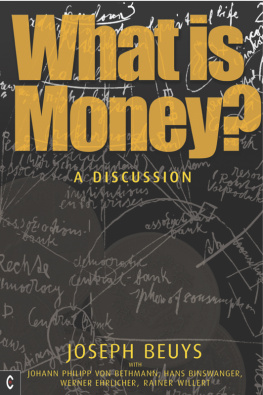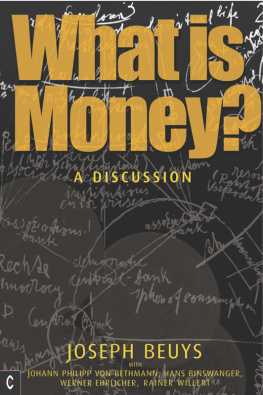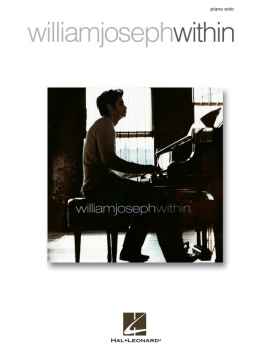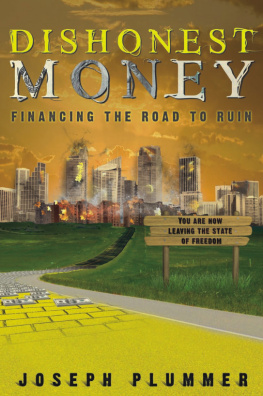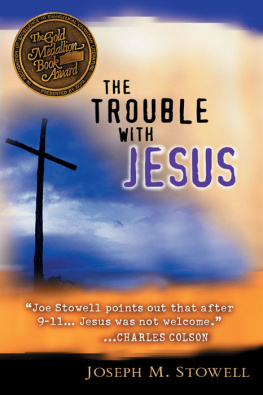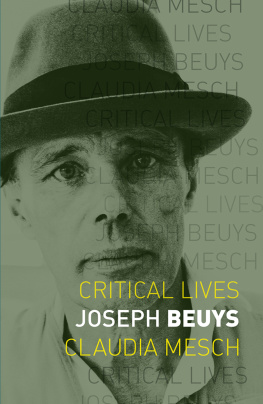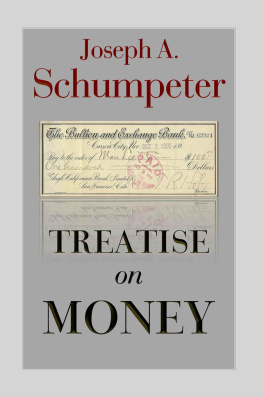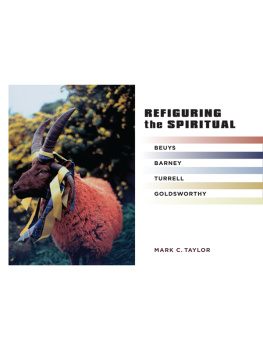Joseph Beuys - What is Money?
Here you can read online Joseph Beuys - What is Money? full text of the book (entire story) in english for free. Download pdf and epub, get meaning, cover and reviews about this ebook. year: 2012, publisher: Clairview Books Ltd, genre: Art. Description of the work, (preface) as well as reviews are available. Best literature library LitArk.com created for fans of good reading and offers a wide selection of genres:
Romance novel
Science fiction
Adventure
Detective
Science
History
Home and family
Prose
Art
Politics
Computer
Non-fiction
Religion
Business
Children
Humor
Choose a favorite category and find really read worthwhile books. Enjoy immersion in the world of imagination, feel the emotions of the characters or learn something new for yourself, make an fascinating discovery.
- Book:What is Money?
- Author:
- Publisher:Clairview Books Ltd
- Genre:
- Year:2012
- Rating:4 / 5
- Favourites:Add to favourites
- Your mark:
- 80
- 1
- 2
- 3
- 4
- 5
What is Money?: summary, description and annotation
We offer to read an annotation, description, summary or preface (depends on what the author of the book "What is Money?" wrote himself). If you haven't found the necessary information about the book — write in the comments, we will try to find it.
Joseph Beuys: author's other books
Who wrote What is Money?? Find out the surname, the name of the author of the book and a list of all author's works by series.
What is Money? — read online for free the complete book (whole text) full work
Below is the text of the book, divided by pages. System saving the place of the last page read, allows you to conveniently read the book "What is Money?" online for free, without having to search again every time where you left off. Put a bookmark, and you can go to the page where you finished reading at any time.
Font size:
Interval:
Bookmark:
JOSEPH BEUYS was born in 1921 in Krefeld, Germany. Conscripted into the army, he suffered injuries from several plane crashes. After a period in an English prison camp at the end of the War, he began to study natural science, but disillusioned with its basic tenets he switched to art. From 1947 to 1951 he studied at the Dsseldorf Art Academy with the sculptor Edward Matar. At that time he encountered Rudolf Steiners work. After years of struggling as an artist and times of deep depression, in 1961 Beuys became Professor of Monumental Sculpture at the Dsseldorf Academy, from which he was expelled in 1972 for challenging the quota system by taking on all students who wanted to learn. During this period he worked with groups like Fluxus whose experimental, interventionist events had much in common with his own strategies and concerns. This led, from 1965, to Fluxus-festivals and happenings, and life-long collaborations with artists like Nam June Paik.
Following his first gallery action (a term he coined) in 1965, Teaching Paintings to a Dead Hare, Beuyss international reputation grew. He became known for his largely silent actions with substances, creatures and instruments of all kinds, and provocative formulations like Every Human being is an Artist and Art=Capital. He participated in many major international events, including the Venice Biennale, Edinburgh Festival and five Documenta exhibitions from 1964. In 1979 he was honoured with a major retrospective at the Guggenheim Museum, New York. In the 1980s there were more exhibitions of Beuyss work than of any other artist, and his influence on younger generations of artists has been extensive.
Beuys alchemist, social visionary and artist died in 1986, just after receiving the prestigious Lehmbruck Prize. He left behind him not only numerous large-scale installations and site-works, hundreds of provocative multiples and small objects, thousands of drawings (many on blackboards developed as part of permanent conference / dialogue actions), documented social sculpture forums about energy, new money forms and direct democracy, but above all a methodology, theory of sculpture, and ideas like parallel process and social sculpture. These ideas underlying his major social process works such as Organisation for Direct Democracy, 7000 Oaks, the Free International University and the Honey Pump at the Workplace contain unexplored seeds and are a profound basis for new generations of ecological, social process and interdisciplinary practitioners.
WHAT IS MONEY?
A discussion
JOSEPH BEUYS
with Johann Philipp von Bethmann,
Hans Binswanger, Werner Ehrlicher and
Rainer Willert
Afterword by Ulrich Rsch

Clairview Books
Hillside House, The Square
Forest Row, RH18 5ES
www.clairviewbooks.com
Published by Clairview 2012
Originally published in German under the title Was ist Geld?, Eine Podiumsdiskussion by FlU-Verlag, Wangen, in 1991. This edition is based on the second edition, 2009
Translated from German by Isabelle Boccon-Gibod. Translation revised and edited by Clairview Books
FlU-Verlag, Wangen 2009
This translation Clairview Books Ltd. 2010
Picture credits: p. 8-9, Sdwestpresse, 1.12.88 (photo, S. Resch); p. 26, from catalogue Luna Luna, Munich 1987; front cover, pp. 33, 42, 85, 87, Hallen fr neue Kunst, Schaffhausen (from Mario Kamer, Joseph Beuys, Das Kapital Raum 1970-1977, Heidelberg 1991); p. 54, Achberger Beuys-Archiv, FIU Verlag/Rainer Rappmann
The moral rights of the authors have been asserted under the Copyright, Designs and Patents Act, 1988
All rights reserved. No part of this publication may be reproduced, stored in a retrieval system, or transmitted, in any form or by any means, electronic, mechanical, photocopying or otherwise, without the prior permission of the publishers
A catalogue record for this book is available from the British Library
ISBN 978 1 905570 55 3
Cover by Andrew Morgan Design incorporating a blackboard drawing by Joseph Beuys
Typeset by DP Photosetting, Neath, West Glamorgan
Contents
A discussion held on 29 November 1984 at The Meeting House in Ulm, Germany, between Joseph Beuys, Johann Philipp von Bethmann, Hans Binswanger, Werner Ehrlicher and Rainer Willert
One can only understand what Joseph Beuys says by having already understood him: an overview of Joseph Beuyss concepts of money and capital by Ulrich Rsch
Foreword
Over twenty-five years have passed since this debate took place in Ulm, so it is legitimate to ask why we feel it is still relevant: in what way does it continue to illumine our current economic situation?
While much has changed in the intervening period, some things decidedly have not. Our world is still dominated by a concept of money and capital that makes money into a commodity, the continual object of power struggles and even wars, and a means whereby human labour is degraded into a tradable commodity. Ultimately this outlook is destroying our social and ecological fabric.
Since the western economic system, the social market economy, triumphed globally, it has been generally regarded as the only viable system, obviating the need to search for other, better approaches.
Yet today for instance in ecology we really only treat symptoms rather than causes. Critical potential in our society seems often to have been submerged, frustrated or even paralysed. Underlying causes are not really perceived, let alone discussed. Without proper (that is, appropriate and responsive) insight into a problem, without perceiving what is at work in it, we cannot expect to find remedies. This is true of all fields of endeavour, and especially of money.
The debate published here is the only recorded instance in which Beuys took up the core idea of a transformation of our view of money and capital, and engaged with other views on the subject. It becomes evident that in these competing opinions, Joseph Beuyss unorthodox views are more than able to hold their own as the press reported at the time. The debate is marked by lively and on occasion humorous exchanges.
From the 1970s onwards, Beuys increasingly focused on a new concept of capital and money, drawing essentially on the findings of Wilhelm Schmundt, a student of Rudolf Steiner. In an appendix to the present edition, Ulrich Rsch has compiled and summarized these ideas to help the reader gain better acquaintance with them. In all his work, Beuys was concerned with nothing less than elaborating a view of art that can solve the problem of capital. Right up to his death, he pursued this path unerringly, with the means at his disposal and at the most diverse levels, as recorded for instance in the many board drawings created during the 100 days of the 1977 documenta6 event, in connection with the Honey Pump in the Workplace installation. This, in turn, flowed into The Capital Space 1970-1977, from which the board drawings in this volume are taken, and which is now housed permanently at the Hallen fr neue Kunst [New Art Galleries] in Schaffhausen, Germany. It was this work that gave Rainer Willert the idea of inviting Joseph Beuys to participate in the debate in Ulm.
Here we see Beuys as always pushing at the boundaries of traditions in art which might seek to confine him. In this debate he confronts not only visitors to art galleries but each and every one of us with the unsolved problem of money.
The current economic crisis has highlighted the destructive ways in which we use and abuse our most precious assets: our innate capacities and creativity. We are still caught in the trap of working to earn. Yet we do not in reality merely work to be remunerated, but rather to produce goods and services that serve others, that others need.
Next pageFont size:
Interval:
Bookmark:
Similar books «What is Money?»
Look at similar books to What is Money?. We have selected literature similar in name and meaning in the hope of providing readers with more options to find new, interesting, not yet read works.
Discussion, reviews of the book What is Money? and just readers' own opinions. Leave your comments, write what you think about the work, its meaning or the main characters. Specify what exactly you liked and what you didn't like, and why you think so.

